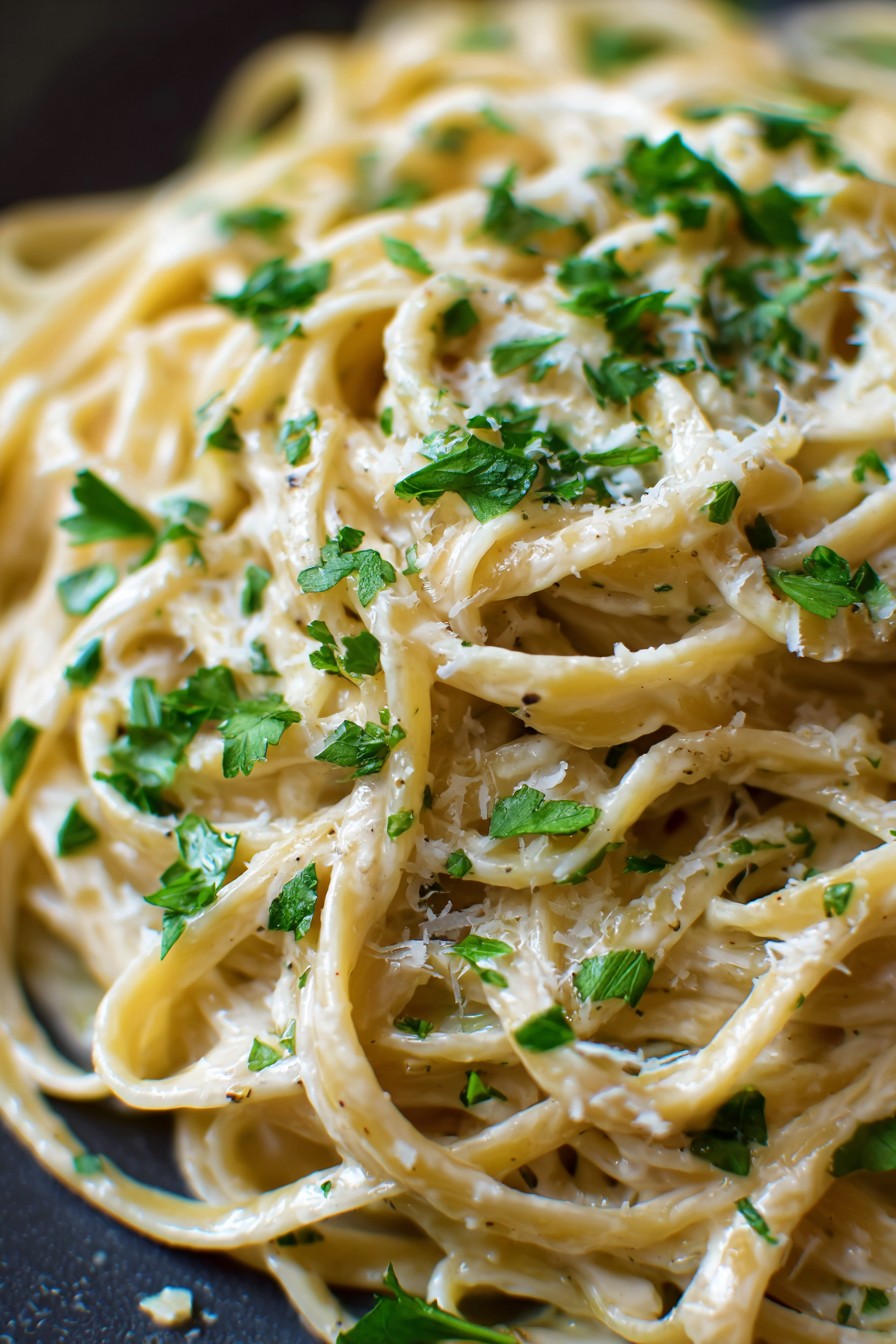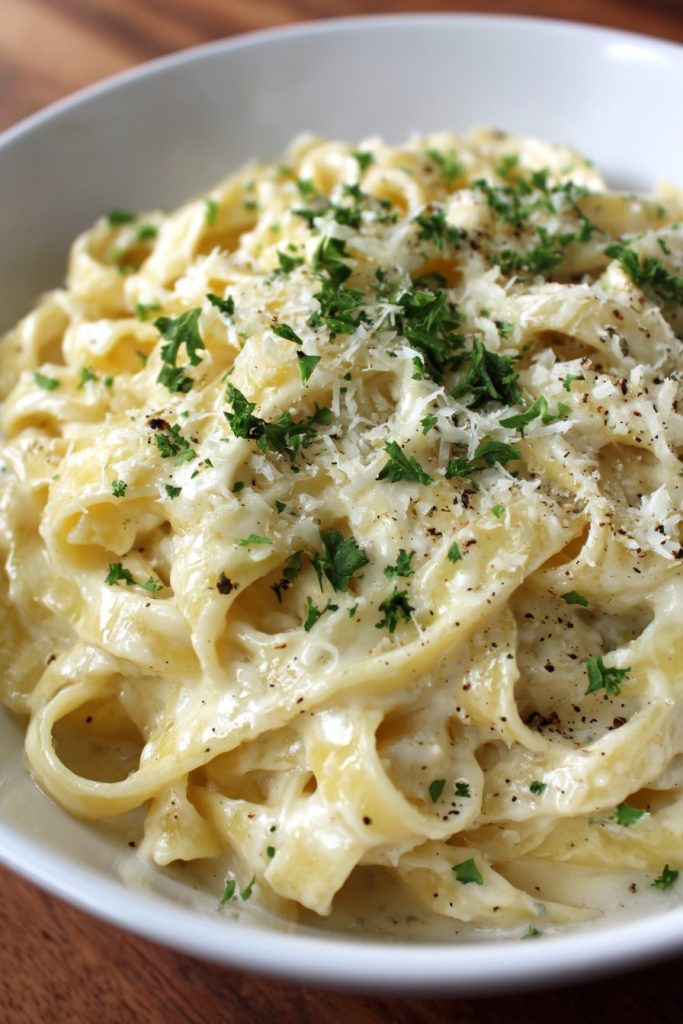Hailing from the cobblestone streets of Rome, where trattoria kitchens whisper secrets of la dolce vita, this creamy garlic pasta sauce captures the essence of Italian comfort with every velvety spoonful. Here in my kitchen, the aroma of toasted garlic and rich cream transports me back to those sun-drenched afternoons near the Pantheon, where simple ingredients transform into culinary poetry that dances on the tongue like a tarantella.
Why This Recipe Works
- The slow-toasting of minced garlic in European-style butter creates a nutty, caramelized foundation that avoids bitterness while developing complex flavor notes reminiscent of Tuscan farmhouse kitchens
- Heavy cream and freshly grated Parmigiano-Reggiano emulsify into a luxurious sauce that clings perfectly to pasta grooves, mirroring the texture of sauces found in authentic Roman trattorias
- Fresh parsley and black pepper provide bright, herbaceous counterpoints to the rich cream base, balancing flavors like the perfect espresso after a Roman feast
- The technique of reserving starchy pasta water ensures proper sauce consistency, a trick Italian nonnas have perfected over generations of family cooking
- Quick preparation time honors the Italian philosophy of cucina povera, where humble ingredients become extraordinary through technique and timing
Ingredients
- 1 pound dried fettuccine pasta
- 6 tablespoons unsalted European-style butter
- 8 large garlic cloves, finely minced
- 2 cups heavy cream
- 1 cup freshly grated Parmigiano-Reggiano cheese
- 1/4 cup chopped fresh Italian parsley
- 1 teaspoon freshly ground black pepper
- 1 teaspoon sea salt
- 1/2 cup reserved pasta cooking water
Equipment Needed
- Large stockpot for boiling pasta
- 12-inch skillet or sauté pan
- Microplane or box grater
- Garlic press or sharp chef’s knife
- Wooden spoon or silicone spatula
- Colander for draining pasta
- Measuring cups and spoons
Instructions

Prepare Your Pasta Foundation
Fill your largest stockpot with 6 quarts of cold water and place it over high heat, bringing the liquid to a vigorous rolling boil that bubbles like thermal springs in Tuscany. Once the water reaches 212°F, add 2 tablespoons of sea salt—the water should taste like the Mediterranean Sea—before gently adding your fettuccine. Stir immediately to prevent sticking, then cook for exactly 8-10 minutes until the pasta reaches al dente perfection, where it offers slight resistance when bitten, much like perfectly cooked pasta in a Roman osteria. Reserve precisely 1/2 cup of the starchy cooking water before draining, as this liquid gold will become the magical binder for our sauce. Tip: Always salt your pasta water generously, as this is your only chance to season the pasta from within, following the Italian principle that properly salted water is the foundation of great pasta dishes.
Toast the Garlic to Perfection
While your pasta cooks, melt 6 tablespoons of European-style butter in your 12-inch skillet over medium-low heat, watching as it foams and subsides like the tide on the Amalfi Coast. Add your finely minced garlic and cook for 3-4 minutes, stirring constantly with a wooden spoon until the garlic turns pale golden and releases its sweet, nutty aroma—this slow toasting process is crucial for developing depth without bitterness. The garlic should sizzle gently rather than aggressively fry, and you’ll know it’s ready when your kitchen smells like a garlic festival in Gilroy meets an Italian countryside kitchen. The transformation from sharp raw garlic to mellow, caramelized perfection is the soul of this sauce, so don’t rush this step even as the anticipation builds.
Create the Creamy Emulsion
Pour 2 cups of heavy cream into the skillet with your toasted garlic, increasing the heat to medium and bringing the mixture to a gentle simmer where small bubbles form around the edges like thermal pools. Cook for 5-7 minutes, stirring occasionally as the cream reduces by about one-third and thickens enough to coat the back of your spoon—this reduction concentrates the flavor while creating the perfect viscosity for clinging to pasta. The cream should bubble lazily rather than boil vigorously, and you’ll notice the color shifting from pure white to a delicate ivory as the flavors meld together in creamy harmony. This slow reduction process mirrors techniques used in French cuisine while maintaining distinctly Italian simplicity.
Incorporate Cheese and Seasonings
Reduce the heat to low and gradually whisk in 1 cup of freshly grated Parmigiano-Reggiano, adding it in three batches to ensure smooth incorporation without clumping—the cheese should melt into the cream rather than seize up. Season with 1 teaspoon of freshly ground black pepper and 1 teaspoon of sea salt, tasting and adjusting as needed to achieve the perfect balance between salty, creamy, and peppery notes. The sauce should now coat your spoon thickly, and if it seems too thick, add a tablespoon of your reserved pasta water to loosen it slightly. Tip: Always grate your cheese fresh rather than using pre-shredded varieties, as the anti-caking agents in pre-shredded cheese can prevent proper emulsification and create a grainy texture.
Combine Pasta and Sauce
Add your drained al dente fettuccine directly to the skillet with your creamy garlic sauce, along with 1/4 cup of your reserved pasta water. Use tongs to toss and lift the pasta continuously for 2-3 minutes until every strand glistens with sauce and the mixture becomes slightly thickened—this tossing technique, called mantecatura in Italian cooking, helps the sauce cling to the pasta. The starch from the pasta water will help the sauce achieve that restaurant-quality cling that makes every bite perfectly sauced. The pasta should appear creamy and luxurious, with no excess sauce pooling at the bottom of the skillet when properly emulsified.
Finish with Fresh Herbs
Sprinkle 1/4 cup of chopped fresh Italian parsley over the sauced pasta, giving one final gentle toss to distribute the bright green herb throughout the dish. The parsley should wilt slightly from the residual heat but maintain its vibrant color and fresh flavor, providing a beautiful visual contrast against the creamy white sauce. Serve immediately in warmed bowls, as pasta waits for no one and is best enjoyed the moment it’s ready, just as they do in the bustling trattorias of Trastevere where timing is everything. Tip: Always warm your serving bowls by rinsing them with hot water before serving—this small detail keeps your pasta hot longer and elevates the entire dining experience.
Tips and Tricks
For those seeking to elevate this already magnificent dish to new heights, consider these advanced techniques drawn from culinary traditions across Italy and beyond. When selecting your garlic, seek out fresh heads with tight, papery skins and firm cloves—the difference between fresh and aging garlic is as distinct as the difference between homemade and store-bought pasta. For the most nuanced flavor profile, consider using a mixture of garlic varieties if available; elephant garlic provides mild sweetness while Russian red garlic offers robust pungency. When toasting your garlic, maintain precise temperature control—if your butter begins to brown significantly before your garlic is ready, remove the pan from heat momentarily to cool before continuing. For cream selection, opt for organic heavy cream with higher butterfat content (around 36-40%) as it emulsifies more smoothly and provides richer mouthfeel. The cheese incorporation stage is where many home cooks stumble—always remove your sauce from direct heat when adding Parmigiano-Reggiano, as excessive heat can cause the proteins to tighten and create graininess. If your sauce does break or become too thick, don’t despair; simply whisk in additional warm cream or pasta water one tablespoon at a time until the emulsion reforms. For those who enjoy textural contrast, reserve some toasted garlic crumbs to sprinkle over the finished dish, creating bursts of intense garlic flavor amidst the creamy background. Storage is another consideration—while best served immediately, any leftovers should be cooled completely before refrigerating in an airtight container for up to three days. When reheating, do so gently over low heat with a splash of cream or milk to restore the sauce’s creamy consistency rather than microwaving, which can cause separation. For dinner party preparation, you can prepare the sauce base up to the cream reduction stage, then finish with cheese and pasta just before serving to ensure optimal texture and temperature. These refinements transform a simple weeknight dish into something worthy of a Roman holiday celebration, where every detail contributes to the overall sensory experience.
Recipe Variations
- Sun-Dried Tomato and Basil Cream Sauce: Incorporate 1/2 cup of chopped oil-packed sun-dried tomatoes during the cream reduction phase, then finish with 1/4 cup of fresh torn basil instead of parsley. The tomatoes add tangy sweetness that contrasts beautifully with the creamy base, while the basil provides an aromatic freshness reminiscent of Ligurian pesto traditions. This variation brings the flavors of Southern Italy to your table, where sun-ripened tomatoes meet creamy indulgence.
- Mushroom and White Wine Cream Sauce: Sauté 8 ounces of sliced cremini mushrooms in the butter before adding garlic, then deglaze with 1/2 cup of dry white wine like Pinot Grigio before adding cream. The mushrooms contribute earthy umami depth while the wine adds bright acidity that cuts through the richness, creating a sauce that would feel at home in a Northern Italian enoteca. The complexity achieved through this layering of flavors demonstrates the sophistication of Italian regional cooking.
- Lemon Zest and Herb Cream Sauce: Add the zest of one large lemon during the final tossing stage along with 2 tablespoons each of fresh chopped chives and tarragon. The citrus brightness elevates the creamy elements while the delicate herbs provide nuanced flavor layers that dance across the palate. This variation draws inspiration from the coastal regions of Italy where citrus and seafood meet in perfect harmony.
- Spicy Arrabbiata-Style Cream Sauce: Include 1 teaspoon of crushed red pepper flakes when toasting the garlic, then finish with 2 tablespoons of chopped fresh oregano. The heat from the pepper flakes creates a wonderful contrast against the cooling cream, while the oregano adds Mediterranean herbaceous notes. This fusion of creamy and spicy elements represents the bold flavors found in Roman cuisine where tradition meets innovation.
- Prosciutto and Pea Cream Sauce: Crisp 4 ounces of diced prosciutto in the butter before adding garlic, then stir in 1 cup of frozen peas during the final minute of sauce simmering. The salty, savory prosciutto and sweet peas create a classic flavor combination that transforms the dish into a complete meal, much like the pasta courses served in Italian family gatherings where every element tells a story.
Frequently Asked Questions
Can I use half-and-half instead of heavy cream for a lighter version?
While you can technically substitute half-and-half, the results will differ significantly in both texture and flavor authenticity. Heavy cream contains 36-40% butterfat, which provides the luxurious mouthfeel and stable emulsion necessary for proper sauce consistency, while half-and-half contains only 10-18% butterfat. When heated, half-and-half is more prone to separation and may result in a thinner, less cohesive sauce that doesn’t cling properly to pasta. If you must reduce fat content, consider using whole milk with 1-2 tablespoons of flour or cornstarch as a thickener, though this will alter the pure, clean flavor profile. The traditional Italian approach favors quality ingredients in proper proportions rather than substitutions, as the cream itself is integral to the dish’s character and cultural authenticity.
How can I prevent my garlic from burning during the toasting process?
Garlic burning is a common concern that can be avoided through proper technique and temperature management. Always use medium-low heat rather than medium or high, and ensure your butter is fully melted and foaming has subsided before adding minced garlic. Constant stirring is crucial—don’t leave the garlic unattended even for moments, as it can transition from perfectly golden to unpleasantly bitter in seconds. If your stove runs hot, consider using a heat diffuser or moving the pan partially off the heat source. Another professional trick is to add a tablespoon of olive oil to your butter, which raises the smoke point and provides additional protection against burning. The goal is slow, gentle toasting that develops flavor complexity without crossing into bitterness.
What’s the best pasta shape to use with creamy garlic sauce?
While fettuccine works beautifully, the sauce pairs excellently with various pasta shapes that can capture and hold the creamy texture. Ribbon pastas like tagliatelle or pappardelle provide substantial surface area for the sauce to cling to, while short shapes like rigatoni, penne, or fusilli trap the sauce in their crevices and tubes. The choice ultimately depends on textural preference—long pastas create elegant, twirlable bites while short pastas offer varied mouthfeel with each spoonful. In Italy, regional traditions often dictate pasta pairings, with cream sauces more common in the north where egg-based pastas originate. Whatever shape you choose, always cook it al dente to maintain structural integrity against the rich sauce.
Can I make this sauce ahead of time for meal preparation?
You can prepare components in advance, but complete assembly is best done just before serving for optimal texture and flavor. The cream sauce base (butter, garlic, and reduced cream) can be refrigerated for up to two days, then gently reheated before finishing with cheese and pasta. However, adding the Parmigiano-Reggiano in advance can cause separation upon reheating, and cooked pasta continues to absorb liquid, potentially becoming mushy. For meal prep, consider storing sauce and pasta separately, then combining with a splash of hot water or cream when ready to eat. The fresh parsley should always be added at the last moment to preserve its vibrant color and delicate flavor. While not ideal for traditional meal prep, this approach maintains more of the dish’s intended character than fully pre-assembled versions.
Is authentic Parmigiano-Reggiano worth the extra cost compared to domestic Parmesan?
Absolutely—the difference between authentic Parmigiano-Reggiano from Italy’s designated regions and domestic imitations is substantial in both flavor and functional properties. True Parmigiano-Reggiano undergoes a minimum 12-month aging process that develops complex nutty, salty, and umami flavors while creating the perfect crystalline structure for melting smoothly into sauces. The protected designation of origin (PDO) ensures specific production methods and milk sources that contribute to its unique characteristics. Domestic Parmesan often contains additives and lacks the depth of properly aged cheese, which can result in grainier texture and less nuanced flavor in your finished sauce. While more expensive, the authentic version provides superior results that honor the dish’s Italian heritage.
Summary
This creamy garlic pasta sauce transforms simple ingredients into Roman-inspired luxury through careful technique and quality components. The slow-toasted garlic foundation, rich cream reduction, and proper emulsification create a restaurant-quality dish that honors Italian culinary traditions while adapting beautifully to home kitchens. With endless variation possibilities and advanced techniques for refinement, this recipe serves as both a reliable staple and creative canvas for culinary exploration.



